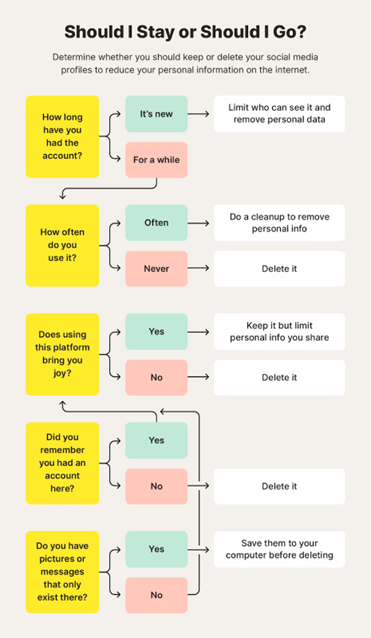How to delete your digital footprint: Complete guide
Your digital footprint includes all traces of your online activity, from your comments on news articles or social media sites to your online shopping preferences. Find out the extent of the digital breadcrumbs you leave behind so you can take better control over your online presence. Then, get Norton AntiTrack to help stop companies from tracking and profiling your online behavior.

What is a digital footprint?
A digital footprint is the trail of data a person leaves online when using the internet. This data can include your search history, online reviews, photos or videos you’ve uploaded, your newsletter subscriptions, and much more. Footprints are created both actively — through the content you engage with and share — and passively, by tracking your online activity without your knowledge or involvement.
Active vs. passive footprint
There are two types of digital footprints:
- Passive footprints are created without your direct intention. For instance, when a website collects information about how many times you visit, this adds to your digital footprint in a passive manner. You don’t choose to hand them this data — they collect it when a device from your IP address accesses their website.
- Active footprints result from conscious actions you take online. This includes posts on social media platforms, ads clicked, online forms completed, and any deliberate information sharing and online activity you actively engage in.
Both active and passive footprints can be tracked and observed by multiple sources. Taking control of your digital footprint helps protect your identity and boost your online privacy. Using a dedicated privacy app like Norton AntiTrack will help obscure your digital footprint and keep trackers off your trail to help you browse, bank, and shop in peace.
Why is a digital footprint important?
Your digital footprint is important because it can shape your reputation — potentially impacting future relationships, job opportunities, and more. An over-exposed digital footprint can also lead to financial fraud or identity theft if it falls into the wrong hands.
- Online reputation matters: Your digital footprint can influence how others perceive you professionally and personally. Employers, educational institutions, potential business partners, and dates often conduct online searches to learn more about individuals.
- Longevity of data: Information shared online can have a long lifespan, even if you try and delete it. Once data is on the internet, it can be challenging to erase. Always consider what you share and protect your private information online.
- Negative financial implications: If cybercriminals get their hands on your personal information, they can use it to launch social engineering attacks. They may do this to steal your identity or money.
Your digital footprint is probably larger than you think. Consider how much time you spend online and everything you do, from watching movies to shopping. All that activity can paint a detailed (and potentially invasive or disturbing) picture of you.
How to check your digital footprint
There are four main ways to check your digital footprint: search your name in Google, check your online accounts, look for any data breaches you may have been exposed to, and use digital footprint checkers.
- Google your name: Enter your full name into search engines like Google and Bing. If you’ve ever changed your name, search your prior name too. Make sure you also check the image and video results to see if you pop up there.
- Check your public accounts: Go to your social media and other online accounts that are public and review the information that others can see. This is all part of your digital footprint.
- Check for data breaches: Use a reliable breach detection service that lets you enter your email address and check if any associated online accounts have been exposed in a data breach.
- Use digital footprint checkers: These can be useful in getting a more comprehensive overview of your footprint than a manual search. But there are some factors to consider like cost, whether they catch data on new sites or platforms, and understanding what they do with your data.
Now that you know what information is out there, you may want to delete some. And if it’s sensitive information, you likely need to.
How to remove personal information from the internet
To delete and keep your personal information off the internet, adjust security features on your devices and browser, delete unused apps and online accounts, request that data be removed from Google, and opt out of data collection services.

1. Use security features on websites, hardware, and apps
Clearing cookies regularly will boost your privacy by preventing websites from tracking your online activity. Many modern operating systems let you control how and when you’re being tracked online, so check the security settings on your devices and adjust them, so your data isn’t saved and your online fingerprint remains more obscure. Before installing a new app, check what data it will share and adjust the privacy settings once you download it.
2. Delete unused apps from your devices
The apps you use on your mobile, tablet, and computer are another source of personal information. If you signed up for an account to use an app or the app is tracking your behaviour, that data could be used or shared with another party.
It’s a good idea to delete as much information as possible before deleting an app. Once you’ve done this, close the account.
3. Remove personal information from Google
There are a couple of ways to request personal information be removed from Google search results:
- Request personal information be removed from Google search results by using this form.
- Request to remove personally identifiable information or doxxing content from Google search results by clicking Start removal request on this page.
4. Erase old email accounts
If you’re like most people, you share and receive a lot of sensitive information over email. From bills with your address and other data to tax details, if your email is hacked your identity and finances are at risk. Once you’ve erased your emails, delete the old email account permanently.
5. Delete unused shopping accounts
Many of us have signed up for an online account because the website promised a discount or free shipping. The downside of these accounts is that everything from your address to your payment information is in the hands of a third party. If they suffer a data breach, your information could be exposed.
6. Remove social media accounts you don’t use
From the old days of MySpace to the ubiquity of TikTok today, there’s no shortage of social media sites to choose from — and share your personal information on.
Even if you haven’t used an account in several years, it could be exposing your personal information to data brokers or others. Close your old social accounts to remove another source of your data from the internet.

7. Opt out of people search sites
People search sites like 192.com are repositories of personal information like addresses and phone numbers. Remove yourself from these sites to make it more difficult for spammers or cybercriminals to find you.
8. Remove your information from data broker sites
Data brokers collect and sell your data. Manually opting out usually requires sending an email or completing an online form, depending on the site. There are lots of data brokers, so using a third-party service can be a good option, although you’ll usually have to pay. Some, like OptOut UK, have a free plan, but it is limited.
9. Clean up or delete old blogs and websites
Remove information about yourself on old websites — your own sites or other sites. Here’s a list of sites you should check:
- Personal websites you created.
- Former employers’ sites with an outdated team page.
- Clubs and organisations you’re no longer a part of that show your name and photo.
- Forums you no longer post on where you used your real name.
If your info is on a site you don’t own, email the webmaster and ask them to remove any reference to you. Provide them with URLs to make it easier for them to find these instances.
How to protect your digital footprint
You can protect your digital footprint by deleting unused accounts or apps, updating the privacy settings of current accounts and apps, reviewing social media accounts, being mindful of what you share online, using a VPN on public Wi-Fi, and staying vigilant for scams.
- Delete unwanted accounts: If you have old accounts or apps that you no longer use, consider deleting them. Dormant accounts can still be part of your online presence and may contain sensitive personal data.
- Regularly update privacy settings: Update privacy settings on current apps and accounts so you’re protected. Digital platforms and online services frequently update their privacy settings, so stay informed about these changes and adjust your settings accordingly to maintain control over who can access your information.
- Review social media accounts: Make your social media accounts private wherever you can. Go through your accounts, review your posts and comments, and delete or modify posts that may compromise your online reputation or that you don’t agree with anymore.
- Be mindful of what you share: Avoid oversharing online. Even seemingly harmless information can build up to paint a picture about you. Remember that even with privacy settings, there's no guarantee that your content will remain entirely private.
- Be careful using public Wi-Fi: Traffic on unsecured public Wi-Fi can be vulnerable to interception. Use a trusted VPN like Norton VPN when using public Wi-Fi. It encrypts the data you send and receive to help protect it from prying eyes.
- Watch out for scams: Don’t click suspicious links or share personal information with unknown sources, whether on the web or within apps. Phishing attempts and scams can lead to more of your sensitive information being leaked onto the internet.
Protect your digital footprint with Norton AntiTrack
Your online presence can play a significant role in how others perceive you, and exposing sensitive information can leave you vulnerable to hacking or scams. Practice good digital hygiene to manage your active digital footprint and use anti-tracking software to help reduce your passive footprint.
Norton AntiTrack will help stop targeted ads, clear tracking cookies, and strengthen your online privacy. While it can’t stop you from sharing what you ate for lunch on social media, it will be there for you to help limit the digital breadcrumbs you leave behind.
Editorial note: Our articles provide educational information for you. Our offerings may not cover or protect against every type of crime, fraud, or threat we write about. Our goal is to increase awareness about Cyber Safety. Please review complete Terms during enrollment or setup. Remember that no one can prevent all identity theft or cybercrime, and that LifeLock does not monitor all transactions at all businesses. The Norton and LifeLock brands are part of Gen Digital Inc.





Want more?
Follow us for all the latest news, tips and updates.